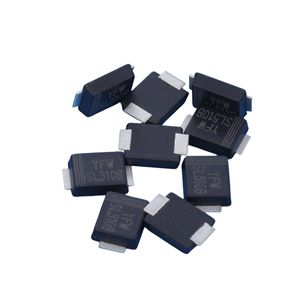Date:2024-09-25 Categories:Product knowledge Hits:470 From: Guangdong Youfeng Microelectronics Co., Ltd(YFW)
The structural principle of Schottky rectifier diode is very different from that of PN junction rectifier diode. PN junction rectifier diode is usually referred to as junction rectifier diode, while metal semiconductor rectifier diode is referred to as Schottky rectifier diode. When using Schottky Schottky diodes, they can only be replaced with Schottky diodes. Schottky diode, also known as Schottky barrier diode (SBD), is a low-power, ultra high speed semiconductor device.
The most significant feature is the extremely short reverse recovery time (which can be as small as a few nanoseconds), and the forward conduction voltage drop is only about 0.4V. It is commonly used as a high-frequency, low-voltage, high current rectifier diode, freewheeling diode, protection diode, and also as a rectifier diode and small signal detection diode in circuits such as microwave communication. It is quite common in communication power supplies, frequency converters, etc.
The main advantages of Schottky rectification Schottky include two aspects:
Due to the Schottky barrier height being lower than the PN junction barrier height, its forward conduction threshold voltage and forward voltage drop are lower than those of PN junction diodes (about 0.2V lower).
2. As SBD is a majority carrier conductive device, there are no issues with minority carrier lifetime and reverse recovery. The reverse recovery time of SBD is only the charging and discharging time of Schottky barrier capacitors, which is completely different from the reverse recovery time of PN junction diodes. Due to the very low reverse recovery charge of SBD, the switching speed is very fast and the switching loss is particularly small, making it particularly suitable for high-frequency applications. It has the advantages of high switching frequency and reduced forward voltage, but its reverse breakdown voltage is relatively low, mostly not higher than 60V, with a maximum of only about 100V, which limits its application range.

Previous: Classification, Structure, and Principle of MOSFET